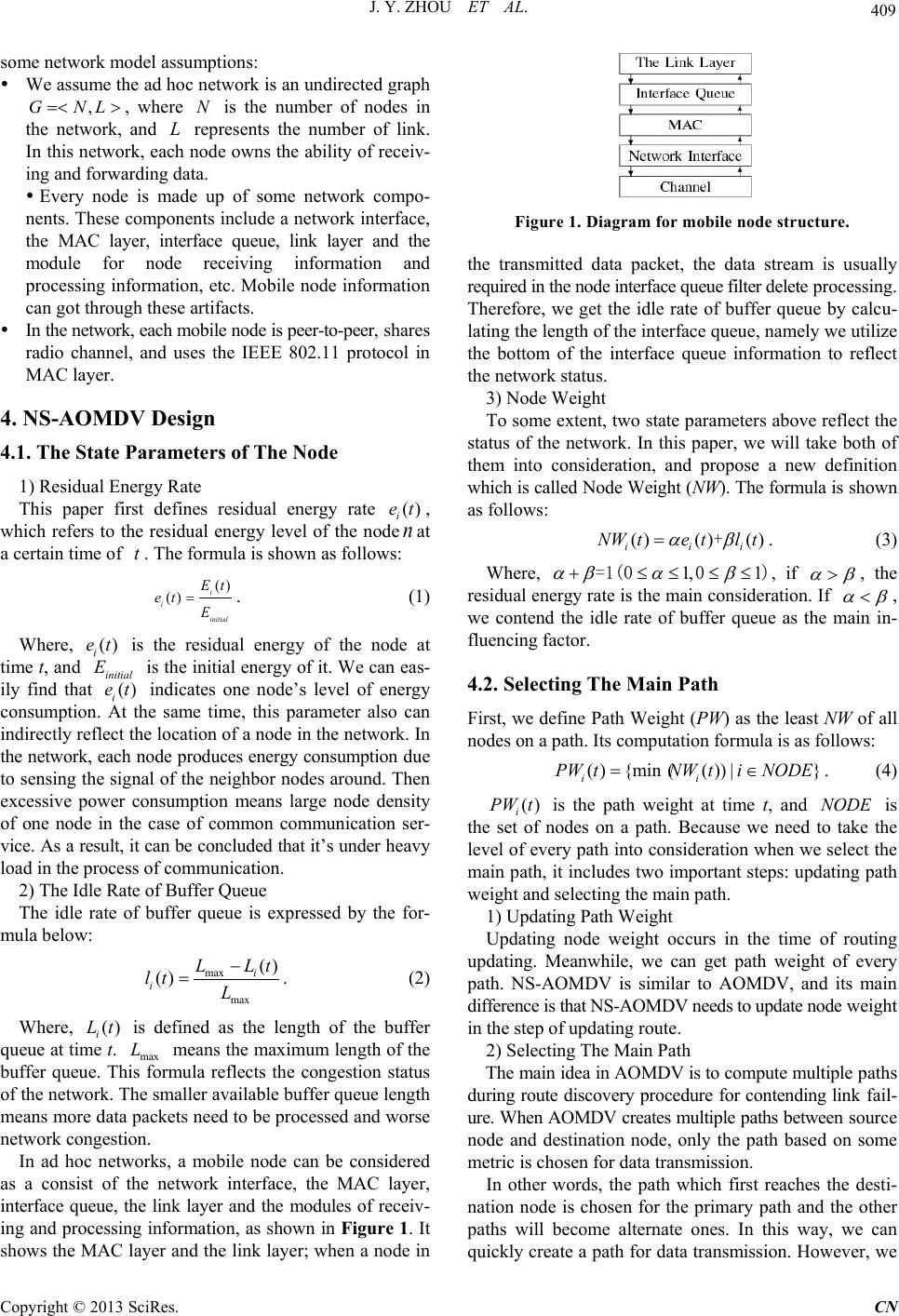
J. Y. ZHOU ET AL.
Copyright © 2013 SciRes. CN
some network model assumptions:
We assume the ad hoc network is an undirected graph
, where
is the number of nodes in
the network, and
represents the number of link.
In this network, each node owns the ability of receiv-
ing and fo rwardin g da ta.
Every node is made up of some network compo-
nents. These components include a network interface,
the MAC layer, interface queue, link layer and the
module for node receiving information and
processing information, etc. Mobile node information
can got through these artifacts.
In the network, each mobile nod e is p eer-to-peer, shares
radio channel, and uses the IEEE 802.11 protocol in
MAC layer.
4. NS-AOMDV Design
4.1. The State Parameters of The Node
1) Residual Energ y Rate
This paper first defines residual energy rate
,
which refers to the residual energy level of the node
at
a certain time of
. The formula is shown as follows:
. (1)
Where,
is the residual energy of the node at
time t, and
is the initial energy of it. We can eas-
ily find that
indicates one node’s level of energy
consumption. At the same time, this parameter also can
indirectly reflect the location of a node in the network. In
the network, each node produces energy consumption due
to sensing the signal of the neighbor no des around. Then
excessive power consumption means large node density
of one node in the case of common communication ser-
vice. As a result, it can b e concluded that it’s under heavy
load in the process of communication.
2) The Idle Rate of Buffer Queue
The idle rate of buffer queue is expressed by the for-
mula below:
. (2)
Where,
is defined as the length of the buffer
queue at time t.
means the maximum length of the
buffer queue. This formula reflects the congestion status
of the network. The smaller available buffer queue length
means more data packets need to be processed and worse
network congestion.
In ad hoc networks, a mobile node can be considered
as a consist of the network interface, the MAC layer,
interface queue, the link layer and the modules of receiv-
ing and processing information, as shown in Figur e 1. It
shows the MAC layer a nd the link layer; when a node in
Figure 1. Diagram for mobile node structure.
the transmitted data packet, the data stream is usually
required in the node interface queue filter delete processing.
Therefore, we get the idle rate of buffer queue by calcu-
lating the length of the interface queue, namely we utilize
the bottom of the interface queue information to reflect
the network status.
3) Node Weight
To some extent, two state parameters above reflect the
status of the network. In this paper, we will take both of
them into consideration, and propose a new definition
which is called No de Weight (NW). The formula is shown
as follows :
. (3)
Where,
, if
, the
residual energy rate is the main consideration. If
,
we contend the idle rate of buffer queue as the main in-
fluencing factor.
4.2. Selecting The Main Path
First, we define Path Weight (PW) as the least NW of all
nodes on a path. Its computation formula is as follows:
() {min(())|}
ii
PW tNW tiNODE= ∈
. (4)
is the path weight at time t, and
is
the set of nodes on a path. Because we need to take the
level of every path into consideration when we select the
main path, it includes two important steps: updating path
weight and selecting the main path.
1) Updating Pa th Weight
Updating node weight occurs in the time of routing
updating. Meanwhile, we can get path weight of every
path. NS-AOMDV is similar to AOMDV, and its main
difference is that NS-AOMDV needs to update node weight
in the ste p of updatin g route.
2) Selecting The Main Path
The main idea in AOMDV is to co mpute mult iple paths
during route discovery procedure for contending link fail-
ure. When AOMDV creates multip le paths between source
node and destination node, only the path based on some
metric is chosen for data transmission.
In other words, the path which first reaches the desti-
nation node is chosen for the primary path and the other
paths will become alternate ones. In this way, we can
quickly create a path for data transmission. However, we